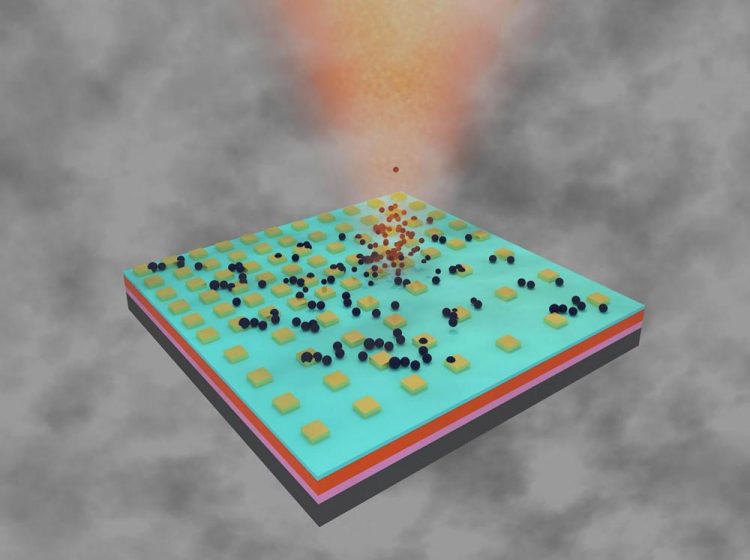Microscale IR spectroscopy enabled by phase change materials and metasurfaces

Illustration of the metasurface interacting with gas molecules. Credit: Courtesy of SUTD
This infrared resonance can then be used to identify or “fingerprint” the molecules.
The infrared is, therefore, useful for a range of applications, including atmospheric pollution monitoring, detecting explosives and narcotics, measuring food quality, and many others.
However, infrared optical components tend to be large, expensive, and non-tuneable.
Researchers from the Singapore University of Technology and Design (SUTD) in collaboration with Dalian University of Technology (DUT) and the Singapore Sinchrotron Light Source (SSLS), have demonstrated that tuneable phase change materials, which are more typically found in data storage devices, can be used to tune the response of microscale infrared transmissive “metasurface” filters.
The filters can be tuned across the broad band of frequencies in the mid-infrared spectrum where many pollutant gasses vibrate.
SUTD lead researcher, Assistant Prof Robert Simpson said: “These infrared filters are so small that they can be incorporated into a smart phone.
This would allow you to measure the quality of the oil that has been used to fry your food, measure the air that you breathe, or to measure fluids that are expelled from your body to check the condition of your health.”
This research was published in Advanced Optical Materials, which is renowned for publishing breakthrough interdisciplinary research that focuses on light matter interactions.
Media Contact
More Information:
http://dx.doi.org/10.1002/adom.201701346All latest news from the category: Materials Sciences
Materials management deals with the research, development, manufacturing and processing of raw and industrial materials. Key aspects here are biological and medical issues, which play an increasingly important role in this field.
innovations-report offers in-depth articles related to the development and application of materials and the structure and properties of new materials.
Newest articles

A universal framework for spatial biology
SpatialData is a freely accessible tool to unify and integrate data from different omics technologies accounting for spatial information, which can provide holistic insights into health and disease. Biological processes…

How complex biological processes arise
A $20 million grant from the U.S. National Science Foundation (NSF) will support the establishment and operation of the National Synthesis Center for Emergence in the Molecular and Cellular Sciences (NCEMS) at…

Airborne single-photon lidar system achieves high-resolution 3D imaging
Compact, low-power system opens doors for photon-efficient drone and satellite-based environmental monitoring and mapping. Researchers have developed a compact and lightweight single-photon airborne lidar system that can acquire high-resolution 3D…





















